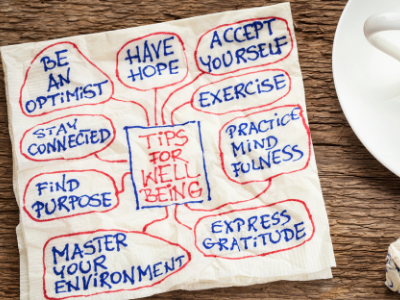We often think that if we diet, exercise more, and focus on weight loss, it will help us become healthy. The problem with focusing solely on these things, having that aim to get to a weight-loss goal as fast as we can, whatever it takes, is that we dramatically miss the mark on what being healthy and fit is all about. Being healthy and fit is about so much more than weight loss: it’s about wellness.
Wanting weight loss for better health is not a bad thing. But thinking weight loss is the key to better health is why we can never seem to stay on track when it comes to a healthier body. When aiming for wellness, this means you embody all aspects, which includes physical, mental, and emotional health. By focusing on all the pillars of wellness, it can lead to weight-loss and give you a better chance of maintaining it. When we skip the mental aspects of wellness, we have a hard time focusing, staying motivated, and can’t seem to create consistency around daily wellness, and this can make achieving a healthy body more difficult.
Stress is something most of us experience and have a hard time managing. We may even think we are okay and don’t believe our stress levels are all that high. Unfortunately, many of us are walking around in a chronic stress state.
Stress alone can cause many health issues that a diet and exercise can’t solve:
- Decreased nutrient absorption: due to decreased enzymatic production from the stomach, pancreas, and liver, decreased bile flow from gallbladder, and decreased oxygenation and gastrointestinal blood flow.
- Increased nutrient excretion: urinary loss of calcium, magnesium, potassium, zinc, chromium, selenium, and various microminerals.
- Decreased gut flora populations: healthy intestinal bacteria are destroyed by stress, which can lead to immune problems, skin disorders, nutrient deficiencies, and digestive distress.
- Increase in salt retention: can lead to high blood pressure
- Decrease in thyroid hormone: can lead to a decrease in metabolic activity throughout the body.
- Increase in blood cholesterol: stress by itself will raise LDL (the “bad” cholesterol) levels.
- Increase in blood platelet aggregation: can lead to blood clots; is a major risk factor in heart disease.
- Decrease in sex hormones: can mean lower sex drive, low energy, decreased muscle mass, and low fertility.
- Increase in inflammation: the basis of many significant ailments, including brain and heart disease. Cortisol, which is released when we are stressed, lowers inflammation, but when cortisol is present in high amounts, it affects other systems that increase inflammation.
- Decrease in growth hormone: a key hormone in growing, healing, and rebuilding body tissues; helps to burn fat and build muscle.
- Increase in insulin resistance: chronic low-level stress may cause target cells to become unresponsive to insulin, a factor in diabetes, weight gain, heart disease, and aging.
- Increase in oxidative stress: prematurely ages the body.
- Increase in risk of osteoporosis: stress increases urinary excretion of calcium, magnesium, and boron.
- Decrease in mitochondria quality: mitochondria are the energy powerhouses of the cell; when these tiny cellular organelles are damaged, we literally produce less energy, which can lead to chronic fatigue.
- Affects how you sleep: cortisol levels get out of balance. Instead of higher cortisol in the morning to get you up and motivated, with lower cortisol at night so you sleep, this ends up getting reversed.
- Increased food cravings: stress can lead to needing to be soothed. Food and alcohol are at the top of the list of easy ways to help you feel better.
Society has made us all believe that we should be wearing stress like a badge of honour. Being super busy has become part of what we think makes us successful and important. The truth is, being super busy makes us stressed, and stress makes being healthy harder and harder.
The body reacts to all stressors in the same way. Whether it’s arguing with someone, bad traffic, busy city streets, deadlines at work or kids misbehaving, all create the same response in the brain as being chased by a bear! The brain reflex automatically kicks into “fight, flight or freeze,” and the following physical and mental reactions may happen in combination and/or sequentially:
- Heart rate increases
- Blood pressure increases
- Breathing rate increases
- Blood flow increases in your extremities to get you ready for a fight
- Body shuts down your reproductive and digestive systems
- Higher-level thinking slows down
- Memory focuses on risks and dangers, not on details
This is why we feel flustered, confused, and can’t seem to get things done. This all creates anxiety and just keeps increasing stress. Eventually, your body becomes resistant to a natural stress response. We can become super sensitive and reactive to small stressors that shouldn’t be perceived as a threat but become one. Our bodies create something called cortisol resistance where the levels are continuously high, which blocks the receptors and they can’t do their job properly to help you naturally come down from a stressful situation.
Not all stress responses are accurate. This is due to the body and mind perceiving stress due to fear of what may happen. This is N.U.T.S. = novelty (learning something new, upcoming change to your life); unpredictability; threat to our ego; and the sense of less control. These four factors play a big role in keeping us in a state of chronic stress.
So, a lot of what causes stress in our life is in our control. Even when things happen that aren’t within our control, we do have control in how we respond and how we manage the resulting stress.
As you can see, it won’t matter how much salad you eat or how often you go to the gym — if your cortisol levels are out of balance, dieting and exercise won’t help your health. If anything, the lack of food and high levels of exercise can make things worse.
Our body does need cortisol and it is healthy for our brains and bodies to respond to “threats” around us. This is how we protect ourselves and our loved ones. It’s not short-term stress (swerving to miss an animal on the road or catching yourself from falling) that we have to worry about. The natural and protective response, that fight or flight “alarm reaction,” creates rapid cortisol release — but the stress response is then quickly relieved. This is what we want. Long-term stress is where cortisol levels are constantly high. Our bodies should not have chronically high levels of cortisol. This can lead to depression, suppressed immunity, and severe fatigue.
There are four types of stress:
- Physical: illness, injury, physical threats of violence, poor diet, excessive toxins, extreme temperatures, medications, surgery, jet lag, inadequate sleep, menstruation, alcohol, tobacco, drugs, and excessive exercise/exertion.
- Mental: isolation, information overload, time pressures, uncertainty, lack of control, loss of a loved one, unemployment, relationship difficulties, and job demands.
- Emotional: grief, worry, anger, frustration, anxiety, rage, hopelessness, resentment, boredom, insecurity, paranoia, and failure.
- Perceived stress: how you react to stress and fear of the unknown. This is where the demands of stress exceed the ability to cope.
We live in a world that demands a lot from us. You can’t avoid stress completely, but you can work on how you react and manage your stressors. Here are a few tips to help with keeping your body in a lower stress state, which will help you become healthier:
- Mindful meditation: this is an easier and more manageable way to meditate. It is about controlling your breathing and looking at your current stressors with more perspective, allowing you to problem-solve and deal with things with a clearer, more focused mind. All that is required is 5 minutes, a quiet place, and letting go of self-judgement. Get comfortable, close your eyes, and focus on controlling your breath. Let your thoughts and feelings enter your mind, and notice how they are affecting you. Basically, it’s about just slowing down for a short period of time.
- Journal your thoughts: a great way to manage your day-to-day stressors is to get them down on paper. It lets the negative out and the positive in. Try doing a 30-day gratitude journal. Every day, write down five things you are grateful for that are different from the previous day. This can be a positive interaction you had that day with a stranger, a good workout you had or a friend in your life. They can be small or big. You will start writing down smaller things you notice as you embrace gratitude daily.
- Gentle yoga or movement flows: this settles your nervous system and relieves tension.
- Social connection: spend time with positive, loving people. Focus on genuine friendships. For extroverts, create space for regular social activities.
- Reframe stressful situations: use a more positive viewpoint to make stress less damaging. Instead of asking “why me,” ask instead “what is it doing for me?” — what lesson or new path is being created that we can learn from and turn into something that works for us. Embrace your strengths and use them to help you through hard times.
This can seem very overwhelming if you try to do it all at once, which defeats the purpose of managing stress. Take on one thing and master it. See how you feel. Most likely, adding one or two more things will benefit you, so next, add a new method of managing stress and then master that.
You will notice that your energy levels start increasing, your digestion gets better, you become clearer in your thoughts and, best of all, you feel happier. This leads to making better decisions for your health.
Before jumping on a fad diet and doing a workout program that has you crawling out of the gym, focus on managing your stressors first. See where you are after 30 days. From there, start focusing more on your food choices and more specific workout regimens.
Sources:
Yaribeygi, H., Panahi, Y., Sahraei, H., Johnston, T.P., and Sahebkar, A. 2017. The Impact of Stress on Body Function: A Review. Experimental and Clinical Sciences Journal ,16: 1057–1072. Url: https://www.ncbi.nlm.nih.gov/pmc/articles/PMC5579396/ (accessed Aug. 24, 2021).



